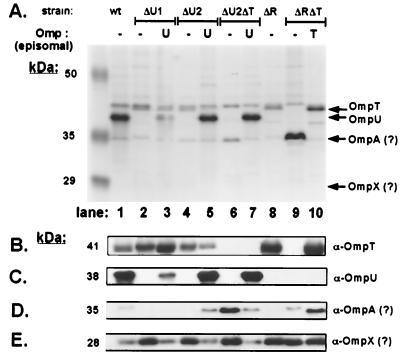FIG. 1.
Expression of OMPs in ompU and ompT mutant V. cholerae strains. (A) OM fractions were prepared (see Materials and Methods) from O395 (wt, wild type, lane 1), KKV669 (ΔU1, ΔompU1, lanes 2 and 3), KKV780 (ΔU2, ΔompU2, lanes 4 and 5), KKV884 (ΔU2ΔT, ΔompU2 ΔompT, lanes 6 and 7), KKV61 (ΔR, ΔtoxR, lane 8), and KKV804 (ΔRΔT, ΔtoxR ΔompT, lanes 9 and 10). Lanes 3, 5, and 7 contain the OM fractions of KKV669, KKV780, and KKV884, respectively, carrying plasmid pKEK253, which expresses ompU from its natural promoter (episomal U). Lane 10 contains the OM fraction of KKV804 carrying plasmid pKEK255, which expresses ompT from its natural promoter (episomal T). Samples were matched by equivalent optical density at 600 nm (OD600) units, separated by SDS–10% PAGE, and stained with Coomassie blue. The mobilities of molecular mass markers are noted in kilodaltons on the left. Arrows on the right indicate the relative migration rates of OmpU, OmpT, OmpA, and OmpX. (B to E) The OM fractions from the wild type and omp mutants (above) were subjected to Western analysis (see Materials and Methods) utilizing rabbit polyclonal antisera against OmpT (B), OmpU (C), and V. cholerae OMPs that cross-reacted with OM protein bands at 35 kDa (D) and 28 kDa (F) (12). V. cholerae OmpA and OmpX are known to migrate at ∼35 and ∼28 kDa (2, 7), and thus the OM proteins seen here may represent OmpA and OmpX (denoted by a question mark).

